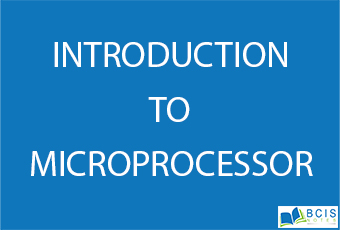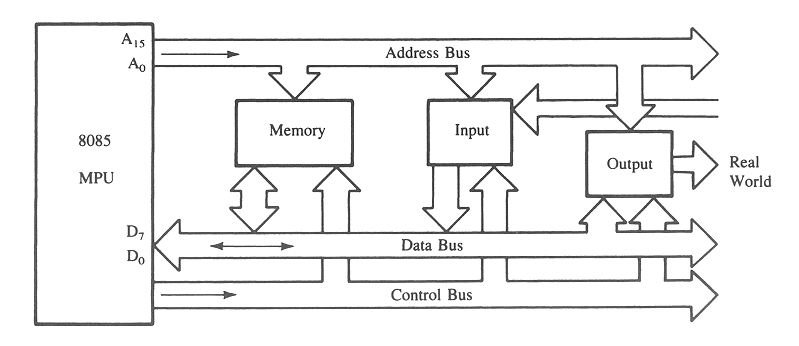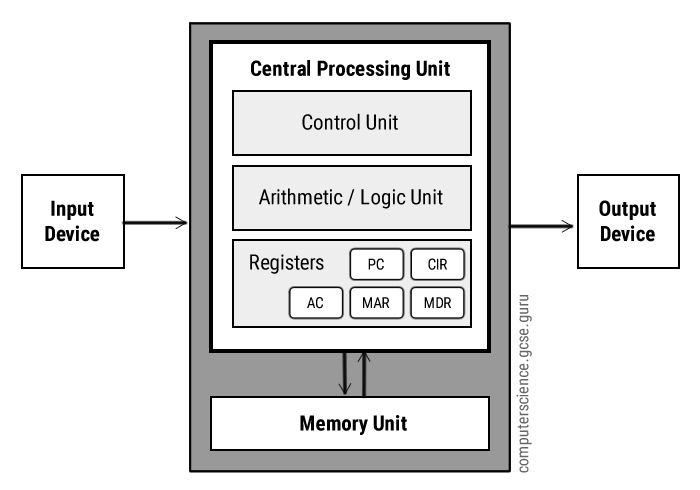
INTRODUCTION to the Microprocessor :-
The microprocessor is a Multipurpose, programmable, clock-driven electronic device that reads binary instructions from a storage device called memory, accepts binary data as input and process data according to those instructions and provides the result as output.
Semiconductor device consisting of electronic logic circuits manufactured by using either a large scale integration (LSI) or very large scale integration (VLSI) techniques.
EVOLUTION OF PROCESSOR MODEL:-
- 1971: Intel 4004 (4 bit up, 2300 transistors,740khz,4096 bytes)
- 1972: Intel 8008
- 1974: Intel 8080
- 1976, march: Intel 8085 ( 8-bit up, 4500 transistors, Mhz, 64Kb)
- 1976, June: Intel 8086 (16-bit up, 29000 transistors, 10 Mhz, 1MB)
- 1979 Intel 8080
- 1970: Motorola, apple used (16 –bit)
- 1993: Intel Pentium, Pentium I, II, III (32-bit, up to 184 million transistors, up to 600 Mhz, 32GB, up to 512 Kb cache memory)
- 2005: Core 2 or Core 2 Duo (64 –bit)
- 2007: Intel Core 2 Quad
- 2007: Intel Core i7 Desktop
- 2009: Intel Core i5 Desktop pro with four core)
- 2010: Intel Core i3 Desktop processor (64-bit)
DIFFERENCE BETWEEN COMPUTER ORGANIZATION AND COMPUTER ARCHITECTURE:-
| Computer Architecture | Computer Organization |
|---|---|
| Computer Architecture is concerned with the way hardware components are connected together to form a computer system. | Computer Organization is concerned with the structure and behavior of a computer system as seen by the user. |
| It acts as the interface between hardware and software. | It deals with the components of a connection in a system. |
| Computer Architecture helps us to understand the functionalities of a system. | Computer Organization tells us how exactly all the units in the system are arranged and interconnected. |
| A programmer can view architecture in terms of instructions, addressing modes and registers. | Whereas Organization expresses the realization of architecture. |
| While designing a computer system architecture is considered first. | An organization is done on the basis of architecture. |
| Computer Architecture deals with high-level design issues. | Computer Organization deals with low-level design issues. |
| Architecture involves Logic (Instruction sets, Addressing modes, Data types, Cache optimization) | Organization involves Physical Components (Circuit design, Adders, Signals, Peripherals) |
HOW IS MICROPROCESSOR MANUFACTURED?
The steps to manufacture microprocessor are:
- Circuit Diagram: At Design centers around the globe experts collaborate to design circuit diagram of Microprocessor, Sophisticated Graphics Process, wireless ICs, etc.
- Quartz Sand: By supply heat, boils thousands of degrees making Silicon ingot (Cylindrical shape).
- Silicon Wafer: Slice number of the piece in circular form.
- Polished (Coated) by the photosensitive chemicals.
- Photolithographic technique: Transfer the circuit structure to wafers bypassing Ultraviolet (UV) Light to the design.
- Moves to ion implantation: The electrical properties of transistors will be specified.
- Atoms are injected (doped) into silicon.
- Finest Interconnect billions of transistors: Copper used.
- Cutting into a piece called a chip.
- Packed chip.
BASIC BLOCK DIAGRAM OF A COMPUTER:-

- MPU: (Micro Processing Unit): Clock Driven semiconductor device consisting of electronic circuits manufactured using either an LSI or VLSI techniques.
- ALU: Area of the Microprocessor where various computing function is performed.
- Register Array: B, C, D, E, H&L are register used for store data temporarily during the execution of the program.
- Control Unit: Provides the necessary timing and controls signals to all the operations in the microcomputers. It also controls the flow of data between the microprocessor & memory & peripherals.
- Memory: It storage binary information as instruction and data & provides that information to the microprocessor whenever necessary.
- RAM (Random Access Memory): Primary memory, CPU only directly access it, Volatile Memory.
- ROM (Read Only Memory): Secondary Memory, used for backup, Non-Volatile Memory. CPU does not directly access it.
- I/O (Input/Output) Device: communicates with the outside world.
BUS ORGANIZATION WITH MICROPROCESSOR
SYSTEM BUS: System bus is a communication path between the microprocessor & peripherals. The system bus is nothing just a group of wires to carry bits.
The MPU (Micro Processing Unit) performs primarily four operations:
- Memory Read: Read data (or instructions) from memory.
- Memory Write: Write data (or instructions) into memory.
- I/O Read: Accepts data from I/P devices.
- I/O Write: Sends data to O/P devices.
TYPES OF SYSTEM BUS
- ADDRESS BUS
It is a group of conducting wires which carry address only. The address bus is unidirectional because of data flow in one direction, from a microprocessor or from a microprocessor to input/output devices (That is, out of microprocessor). Length of Address bus of 8085 microprocessor is 16 bit (That is, four hexadecimal digits), ranging from 0000H to FFFF H. The microprocessor 8085 can transfer maximum 16-bit address which means it can address 65,536 different memory location i.e 64KB memory.
Address Bus is used to perform the first function, identifying a peripheral or a memory location.
- DATA BUS
It is a group of conducting wires which carry data only. The data bus is bidirectional because of data flow in both directions from the microprocessor to memory or input/output devices and from memory or input/output devices to a microprocessor.
Length of Databus of 8085 microprocessor is 8 bit (that is, two hexadecimal Digits0, ranging from 00H to FF H.
The data bus is used to perform the second function, transferring binary information.
- CONTROL BUS
It is a group of conducting wires, which is used to generate timing and control signals to control all the associated peripherals, the microprocessor uses control bus to process data that is what to do with the selected memory location. Some control signals are:
- Memory read
- Memory write
- I/O read
- I/O write
- Opcode fetch
BLOCK DIAGRAM OF 8085 BUS STRUCTURE

OPERATION:
Three steps:-
- MPU (Micro Processing Unit) place 16-bit address on the address bus and memory location are identified after decoded by an external logic circuit.
- MPU sends a pulse called memory read as control signals.
- The pulse activates the memory chip and the content of the memory location (8-bit data) is placed on the data bus and brought inside the microprocessor.
STORAGE PROGRAM CONCEPT
The storage-program concept is designed by Hungarian mathematician John von Neumann. The von Neumann architecture is a design model for a stored-program digital computer that uses a processing unit and a single separate storage structure to hold both instructions and data.
A Von Neumann Architecture computer has five parts: arithmetic –logic unit, a control unit, a memory, some form of input/output and a system bus that provides a data path between these parts.
Program data and instruction data are stored in the same memory. It needs two clock cycles to complete instructions, pipelining instruction was not possible. Data transfer & instruction fetches must be in the schedule because of using only one data bus.
BLOCK DIAGRAM OF VON- NEUMANN ARCHITECTURE

DIFFERENCES BETWEEN MICRO PROGRAMMED CONTROL AND HARDWIRED CONTROL
Micro Processor, Micro-Controller & Micro Computers
A. Microprocessor:
- Application (Eg: Gaming, web browsing, document creation, play movies, etc): basically used in applications where tasks are not pre-defined. It depends upon the user. Eg, PC, Laptop, Mobile
- Internal Structure: Memory & I/O devices connected externally.
- Cost: High
- Power Consumption:high
- Storage : High (126GB to 2TB)
- Overall larger system.
- High speed:1GHz to 4GHz
B. MICROCONTROLLERS
- Applications: Used for specific purposed. E.g. Digital camera, washing machine, air conditioning system, microwave oven, home security system, Industrials robots, ATM, calculators, telephone, etc.
- The repeated same program runs again and again (single task).
- CPU, memory & I/O are present internally.
- Cost: low
- Power consumption: low
- Storage: low (flash memory, 32KB to 2MB)
- RAM: 2KB to 256 KB
C. MICROCOMPUTERS
- A computer with a microprocessor
- eg. daily used laptops, PC, etc.
- Small in size, low in cost & power consumption.
- General computer (Normal Speed, Storage & Performance)
You may also like Microprocessor Operations

I have interest in this, cheers.